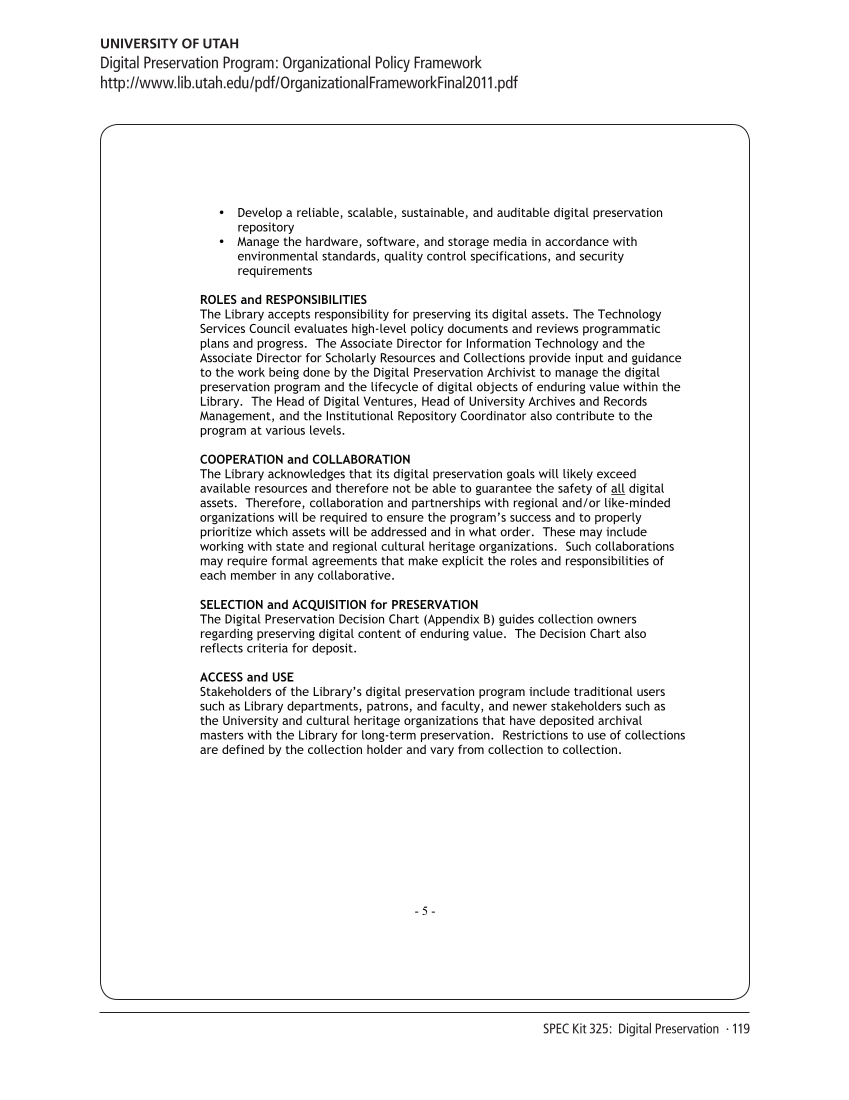SPEC Kit 325: Digital Preservation · 119
University of Utah
Digital Preservation Program: Organizational Policy Framework
http://www.lib.utah.edu/pdf/OrganizationalFrameworkFinal2011.pdf
-5 -
• Develop a reliable, scalable, sustainable, and auditable digital preservation
repository
• Manage the hardware, software, and storage media in accordance with
environmental standards, quality control specifications, and security
requirements
ROLES and RESPONSIBILITIES
The Library accepts responsibility for preserving its digital assets. The Technology
Services Council evaluates high-level policy documents and reviews programmatic
plans and progress. The Associate Director for Information Technology and the
Associate Director for Scholarly Resources and Collections provide input and guidance
to the work being done by the Digital Preservation Archivist to manage the digital
preservation program and the lifecycle of digital objects of enduring value within the
Library. The Head of Digital Ventures, Head of University Archives and Records
Management, and the Institutional Repository Coordinator also contribute to the
program at various levels.
COOPERATION and COLLABORATION
The Library acknowledges that its digital preservation goals will likely exceed
available resources and therefore not be able to guarantee the safety of all digital
assets. Therefore, collaboration and partnerships with regional and/or like-minded
organizations will be required to ensure the program’s success and to properly
prioritize which assets will be addressed and in what order. These may include
working with state and regional cultural heritage organizations. Such collaborations
may require formal agreements that make explicit the roles and responsibilities of
each member in any collaborative.
SELECTION and ACQUISITION for PRESERVATION
The Digital Preservation Decision Chart (Appendix B) guides collection owners
regarding preserving digital content of enduring value. The Decision Chart also
reflects criteria for deposit.
ACCESS and USE
Stakeholders of the Library’s digital preservation program include traditional users
such as Library departments, patrons, and faculty, and newer stakeholders such as
the University and cultural heritage organizations that have deposited archival
masters with the Library for long-term preservation. Restrictions to use of collections
are defined by the collection holder and vary from collection to collection.
University of Utah
Digital Preservation Program: Organizational Policy Framework
http://www.lib.utah.edu/pdf/OrganizationalFrameworkFinal2011.pdf
-5 -
• Develop a reliable, scalable, sustainable, and auditable digital preservation
repository
• Manage the hardware, software, and storage media in accordance with
environmental standards, quality control specifications, and security
requirements
ROLES and RESPONSIBILITIES
The Library accepts responsibility for preserving its digital assets. The Technology
Services Council evaluates high-level policy documents and reviews programmatic
plans and progress. The Associate Director for Information Technology and the
Associate Director for Scholarly Resources and Collections provide input and guidance
to the work being done by the Digital Preservation Archivist to manage the digital
preservation program and the lifecycle of digital objects of enduring value within the
Library. The Head of Digital Ventures, Head of University Archives and Records
Management, and the Institutional Repository Coordinator also contribute to the
program at various levels.
COOPERATION and COLLABORATION
The Library acknowledges that its digital preservation goals will likely exceed
available resources and therefore not be able to guarantee the safety of all digital
assets. Therefore, collaboration and partnerships with regional and/or like-minded
organizations will be required to ensure the program’s success and to properly
prioritize which assets will be addressed and in what order. These may include
working with state and regional cultural heritage organizations. Such collaborations
may require formal agreements that make explicit the roles and responsibilities of
each member in any collaborative.
SELECTION and ACQUISITION for PRESERVATION
The Digital Preservation Decision Chart (Appendix B) guides collection owners
regarding preserving digital content of enduring value. The Decision Chart also
reflects criteria for deposit.
ACCESS and USE
Stakeholders of the Library’s digital preservation program include traditional users
such as Library departments, patrons, and faculty, and newer stakeholders such as
the University and cultural heritage organizations that have deposited archival
masters with the Library for long-term preservation. Restrictions to use of collections
are defined by the collection holder and vary from collection to collection.






























































































































































